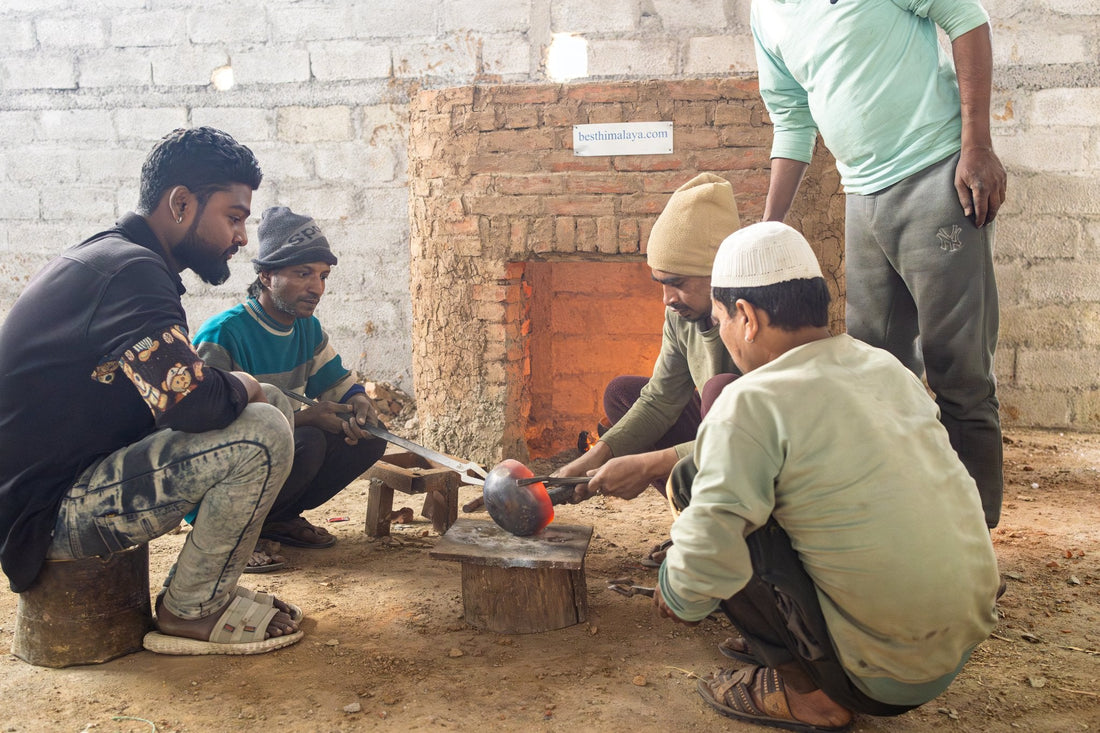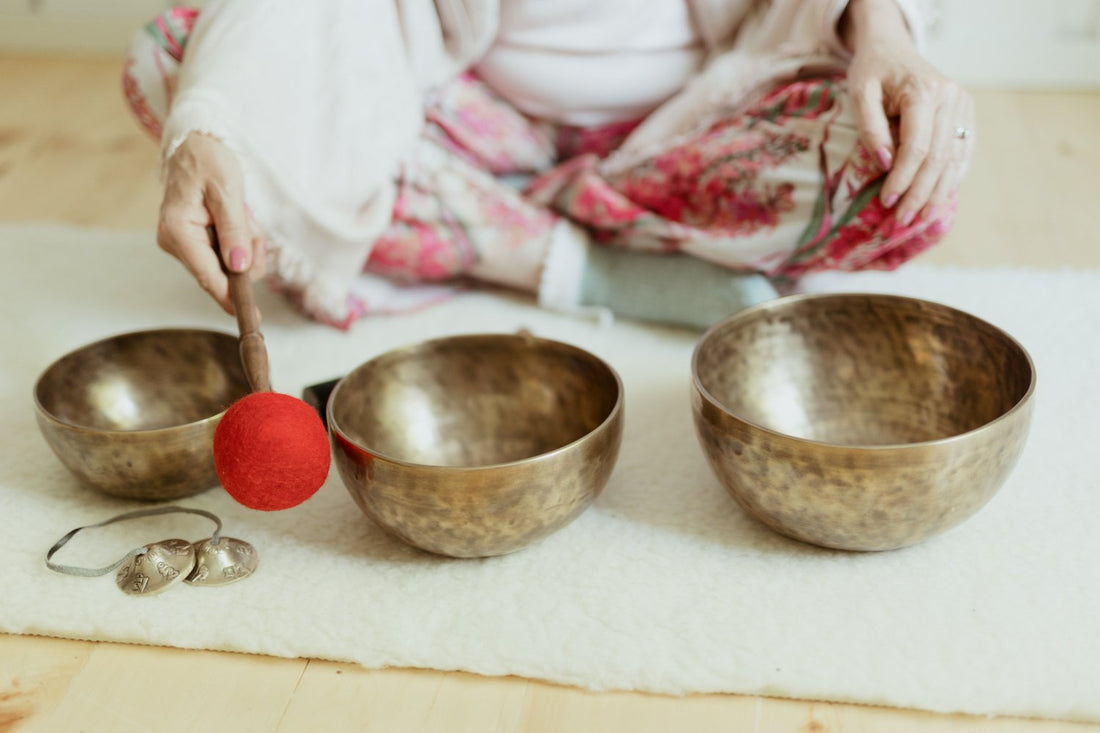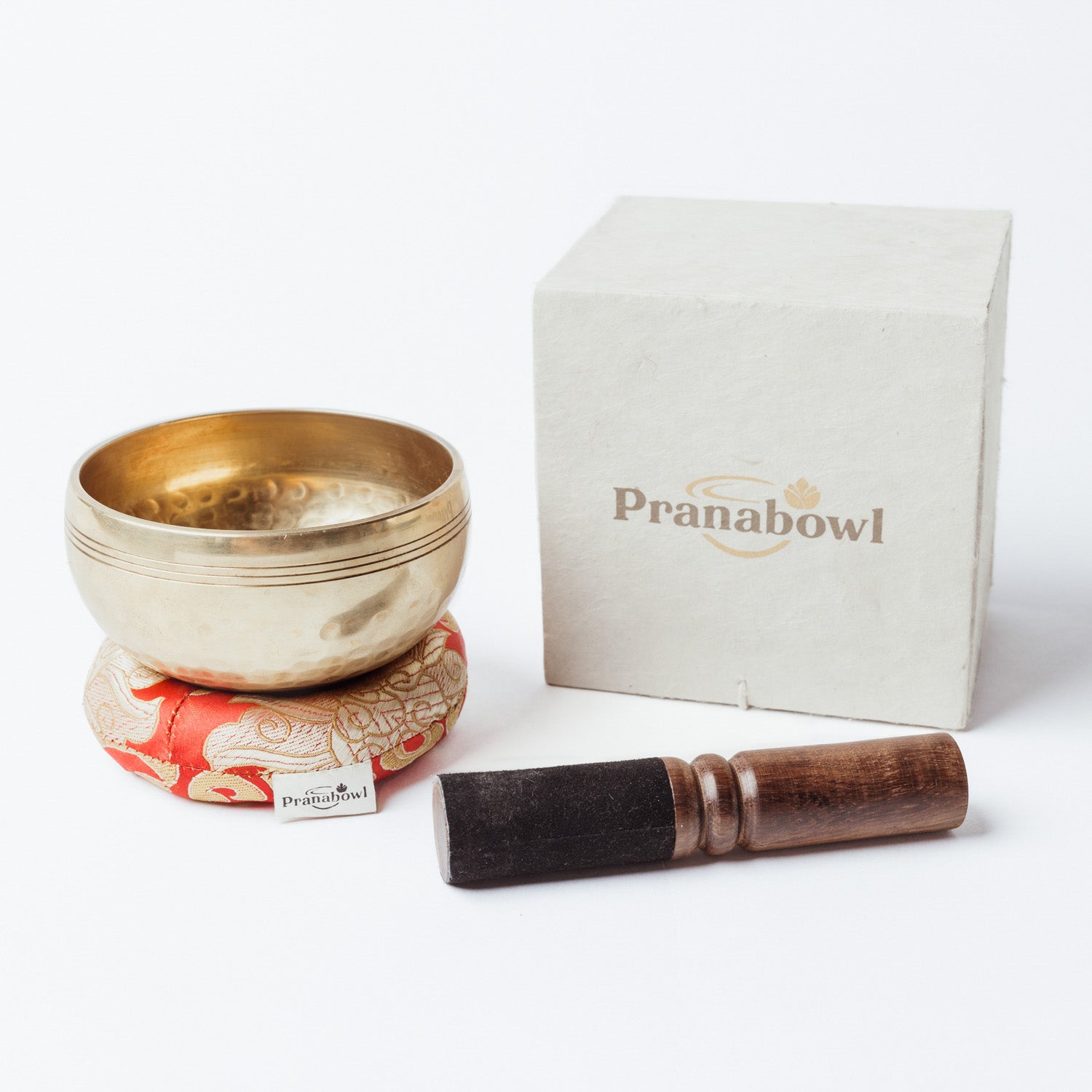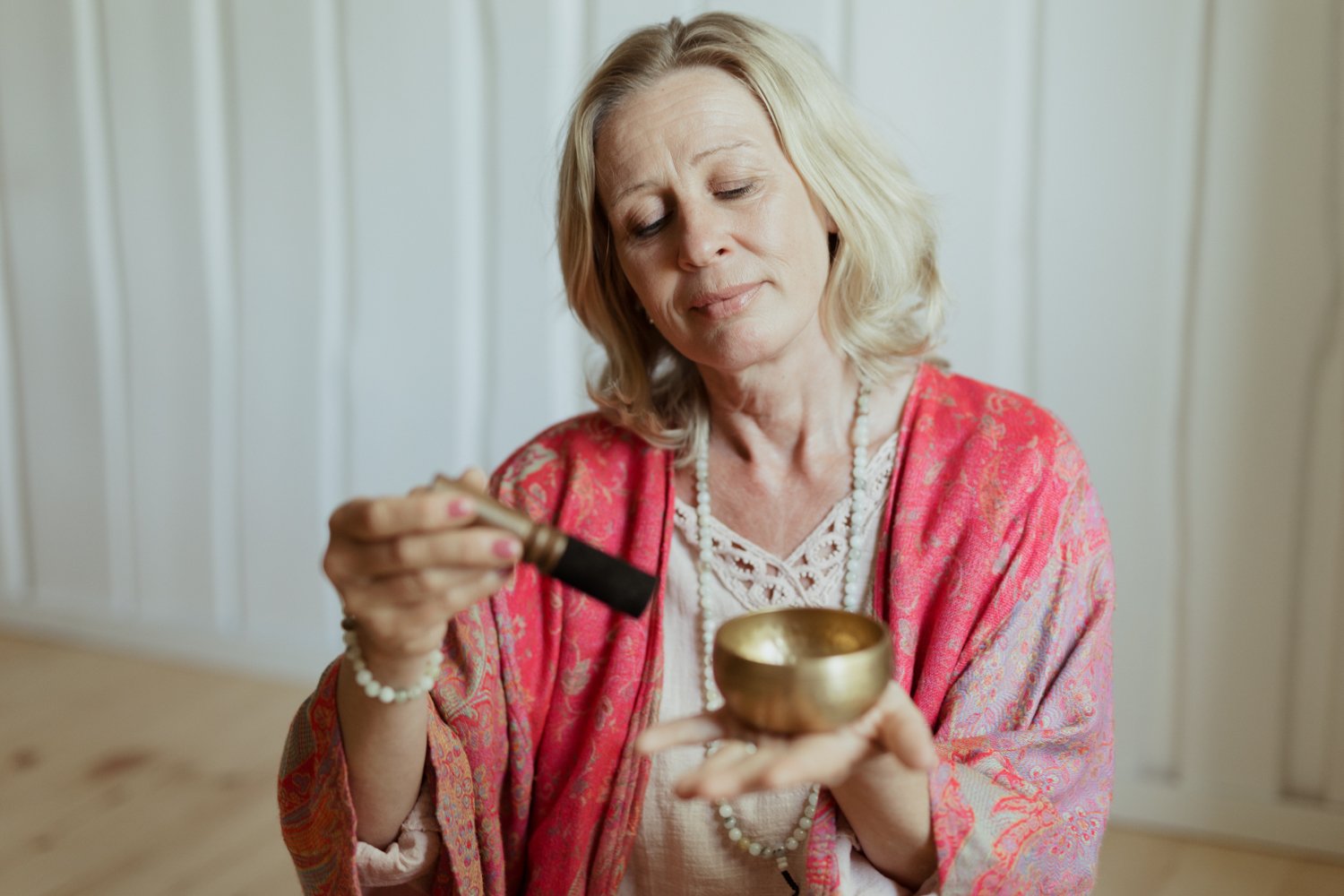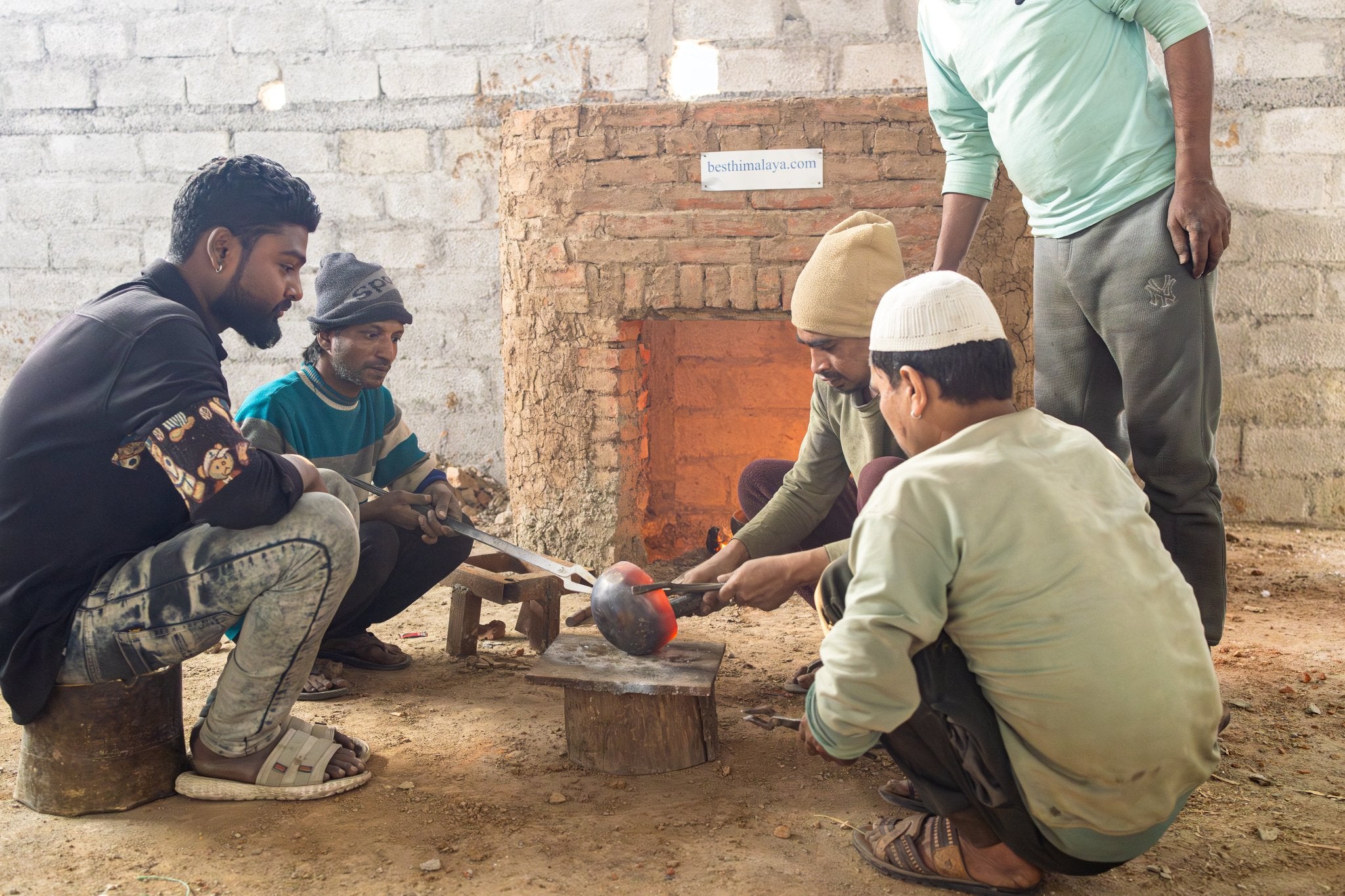
The beginning of Pranabowl
Pranbowl was born from our desire to offer singing bowls of the highest quality and made using traditional methods.
We searched for skilled artisans from the original roots of singing bowls in Nepal, with whom we began a collaboration to make singing bowls.
Real people use their skills to create these authentic and unique products, which we are happy to share with the world, promoting Nepal's valuable cultural heritage of singing bowls.

Terhi and Johanna
Pranabowl founder Terhi Elo graduated as a physiotherapist in the early 1990s and has since trained extensively in various energy therapies.
After his own mystical healing experience, Terhi began to explore the human energy body in greater depth: what drives it and how it can be influenced. This is how he discovered the power of sound vibrations and Tibetan singing bowls.
She has worked with singing bowls for over ten years, managing and training at a course center called Enkelikartano .
Another Prana Bowl trainer, Johanna Sulkumäki , found singing bowls to be helpful for years of chronic fatigue and exhaustion. During the healing process, she eventually turned to holistic wellness.
Johanna has worked for a long time as a singing bowl therapist and trainer, as well as a reiki master.
Terhi and Johanna's own experiences with the healing effects of sound vibrations led to the creation of Pranabowl. Their dream is that everyone could find this natural, easy and affordable way to take care of themselves, their loved ones – and why not also make sound bowl therapy and group relaxations a profession for themselves.

Prana - the life force
Pranabowl is a collection of handmade, high-quality products designed to bring peace, balance and well-being into your life.
The word prana in Sanskrit means life force – the invisible universal energy that sustains the body and flows through all life. Prana connects us to ourselves, each other, and the world around us.
In China, this force is called Chi and in Japan, Qi. In all cases, it is the fundamental energy of life – the force that flows, connects and sustains.
Sounds bring balance
Our hope is to bring balance and well-being to people's everyday lives through sound and vibration.
Our values
Authenticity
Our products are made in the origins of singing bowls in Nepal by local artisans
Balance
Our job is to promote tools for mental balance and calm in today's stressful everyday life.
Ethics
We respect and support Nepalese cultural heritage and expertise as a manufacturer of singing bowls
Responsibility
The production of our products employs local artisans, whose working conditions and compensation are taken care of.

Blog posts
How are singing bowls made?
The making of singing bowls is a centuries-old tradition The making of Tibetan singing bowls is a centuries-old craft that combines expertise, spiritual tradition and an understanding of sound vibrations. Traditional hand-hammered singing bowls are made from a bronze alloy of approximately 73% copper, 25% tin and 2% zinc. Pranabowl singing bowls are made in origins of singing bowl, respecting centuries-old traditions. This unique craftsmanship has been passed down through generations, creating high-quality singing bowls. According to some legends, the bowls are made of seven metals. The seven metals often mentioned are: gold, silver, copper, tin, iron, mercury, and lead. There are two major theories behind the idea of the seven metals. One theory is that these represent the seven planets known to the ancients. The other theory is that these seven metals are derived from sacred minerals and metals of the region. However, this has been shown to be mostly a myth, as tests on singing bowls have not found any significant amounts of these metals. However, there are rumors that some manufacturers may add very small amounts of various metals to keep these claims alive. However, the amount is structurally insignificant. Manufacturing requires professional skills In production, the metal alloy of the sound bowls is melted and cast into a round disc, from which the actual forging process begins. The hot metal disc is forged by hand with hammers – often in collaboration with several craftsmen – slowly and carefully until the round shape of the bowl is created. Each hammer blow has its own meaning: they shape both the external shape of the bowl and its internal resonance. This slow and meditative way of working allows the end result to be a sounding instrument that carries a deep, multi-layered sound and strong vibration. The bowl is cooled, cleaned and finished. The surface of the bowl is often left slightly rough to preserve its authentic look and sound. Singing bowls can also be hand-cast from a single metal, brass. This allows for cost savings while still providing high-quality sound. Brass cast bells are more shiny and decorative in appearance. Handmade with our heart The vibration of a handmade singing bowl is felt strongly throughout the body. For this reason, handmade singing bowls are particularly popular in singing bowl therapies, meditation, and singing bowl relaxation. The sound of a Tibetan singing bowl is not a coincidence, but the result of skill, silence, and countless hammer blows, all made by hand, with heart, and intention.
Learn moreHow Do Singing Bowls Work? Healing Effects and Sound Therapy Benefits
The power of sound vibration Singing bowls have a variety of effects based on the sound waves and vibrations they produce. Sounds affect us on many different levels, both physiologically and energetically, as well as through the sense of hearing and the brain. The effects of singing bowl therapy have been extensively studied, and in our training courses we delve extensively into the research results. Entrainment The deeply relaxing effect of sound vibrations is based, among other things, on synchronization (entrainment), whereby brain waves (electroencephalogram) synchronize with harmonic sounds, shifting them from the beta level to the alpha and theta levels, which are associated with deeper relaxation. Other physiological functions of the body, such as the nervous system, breathing and heart rate, entrain with changes in the electroencephalogram. Calming the nervous system plays an important role The physiological effects of singing bowls are primarily based on calming the nervous system; when playing singing bowls, the aim is to activate the parasympathetic or resting nervous system and calm the sympathetic or stress nervous system. As the nervous system balances, the body begins to return to its normal state, allowing singing bowls to produce a variety of effects on the body and mind. Effects of singing bowls: Stimulation of the vagus nerve drop in blood pressure and slowing of heart rate Deepening of breathing and increased mucus secretion activation of bowel function increased feeling of relaxation reducing stress hormone levels increased secretion of oxytocin, endorphin and serotonin hormones improved sleep quality increased alertness muscle relaxation and relief of muscle tension increased calmness, balance, self-control and self-awareness improvement in body image The path to inner wisdom In addition to the physiological effects, the vibrations and sound waves of the bowls provide holistic care for both the body and mind, and the psychological benefits they bring can be seen as increased emotional balance, new insights, and a lighter feeling. Sounds affect psychological well-being both through the body and by directly treating the mind. When the body and mind become quiet, what remains is presence in the present moment. We all have an inner wisdom, the so-called voice of the soul or heart, which can easily be lost in the constant stream of thoughts. Healing sounds help the body and mind to become quiet, making it easier to access and listen to your own inner wisdom.
Learn moreWhat is singing bowl therapy?
Singing bowl therapy is a general term for individual treatments, self-care, and group relaxations using singing bowls. In all of these, the goal is to achieve physical, mental, and emotional relaxation through sound. Singing bowls in group relaxation Singing bowls are very commonly used as a group relaxation, or so-called chord bath, which is also called Sound healing. During a relaxation session of about 30-60 minutes, group members can curl up under a blanket or sit while listening to beautiful natural sounds and also feel sound vibrations in their bodies. Group relaxation is often experienced as deeply relaxing, and even if the mind does not calm down, activity meters can show up to 20 minutes of deep sleep. The body and body functions are restored, even if the hour is very inspiring on a mental level. In addition to singing bowls, group relaxations can also use gongs, sea drums, koshi and zaphir wind chimes, as well as crystal bowls and harps, rain sticks and other acoustic instruments. However, the main emphasis is always on singing bowls. Singing bowls in individual and couple therapy Individual therapy differs from group relaxation in that the bowls are also played on the client's body. The therapy is performed in both prone and supine positions, and different sized bowls are used on different parts of the body. Individual therapy is slightly more powerful in its effects than group relaxation. Individual therapy usually lasts 60 minutes for adults and the treatment time is shorter for children. Singing bowls can be used for couples therapy, which is a combination of individual therapy and group relaxation. In couples therapy, two clients are treated simultaneously and the bowls are played on and around the body in a chord bath-like manner. Other therapeutic instruments can also be combined with the therapy. Couples therapy is sought by friends, couples, parent-child pairs, etc. Effects of sound bowl relaxation The sound of singing bowls is perceived as pleasant and relaxing, and calming the mind. This causes our brain waves to slow down, which also calms other body rhythms, such as the nervous system, breathing and heart rate. The sound waves emanating from the bowls resonate in our body and the sound vibration can be felt even when the bowl is played further away from the body. Singing bowl relaxation is said to be deeply relaxing for the body, mind and soul. Read more about the effects Disadvantages of Singing Bowl Relaxation The disadvantages of singing bowl therapy are often asked about, and there are some things you should know before going for therapy. The goal of traditional singing bowl therapy is to restore the body to its normal function, both physiologically and energetically. Tibetan and Chinese medicine focus on treating health and strengthening the body holistically on all levels: physical, mental, emotional, and spiritual. Situations where you should exercise caution when using singing bowls include those with a pacemaker, those undergoing cancer treatment, and those who are otherwise seriously ill (physically or mentally). In these cases, you should seek permission from a doctor to determine whether sound relaxation is safe. For example, the effect of sound on cancer cells has already been studied and is still being studied. In light of current research, we do not use singing bowl therapy or group relaxation during cancer treatments, as we do not yet know enough about how different frequencies affect cancer cells. Singing bowl relaxation and pregnancy During pregnancy, you can safely come to a group relaxation or sound bath. Singing bowls are not used during pregnancy when played on the body, as there is no research data on the effect of vibrations on the fetus in amniotic fluid. When played around the body, singing bowl relaxation is safe and wonderful, for both the expectant mother and the fetus. If you are unsure whether you can go for sound bowl therapy or participate in group relaxation, please check with the therapist or group instructor. Our trained sound bowl therapists and sound bath instructors will be able to answer your questions and always put the client's safety first. Self-healing with singing bowls You can easily treat yourself with singing bowls. With regular use, the effects of singing bowls become stronger. Self-treatment can be done with small bowls around the body, enjoying the healing sound. Biscuit-sized and large singing bowls are also suitable for playing on the body, so you can feel the sound vibration in your body. We organize training on self-care of singing bowls and care for family members at the Caring for Singing Bowls Days, which are held at Enkelikartano in Finland.
Learn more

